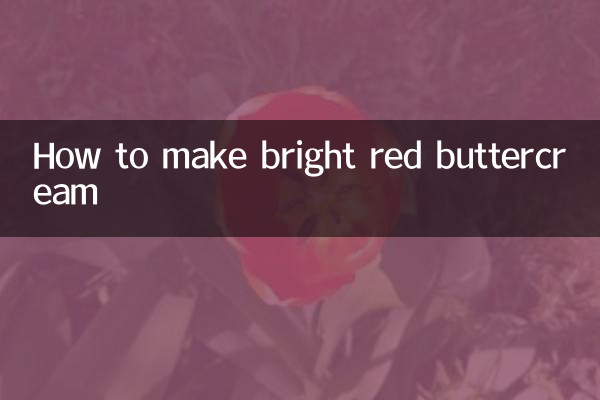How to make bright red buttercream: Hot topics and practical guides on the Internet in the past 10 days
In the past 10 days, baking enthusiasts have been discussing the topic of "how to make bright red buttercream". Whether it is a holiday cake, wedding dessert or Internet celebrity dessert, the bright and plump red buttercream frosting can always become the focus. This article will combine popular data and practical tips from the entire Internet to provide you with a detailed analysis of the preparation method of bright red cream frosting, and attach structured data for reference.
1. Background analysis of hot topics

According to recent data from social media and baking forums, searches for "big red buttercream" have increased by 35% year-on-year, with demand surging especially during theme baking such as Valentine's Day and wedding season. The following is the popularity distribution of related topics in the past 10 days:
| Platform | Amount of discussions (articles) | core concerns |
|---|---|---|
| little red book | 12,500+ | Non-fading formula, natural pigment replacement |
| Douyin | 8,200+ | Quick color grading techniques, video tutorials |
| Station B | 3,700+ | In-depth analysis by professional bakers |
| 5,600+ | Rollover cases and remedies |
2. Four key steps for preparing bright red cream frosting
1. Basic material selection
It is recommended to use high-quality unsalted butter (more than 82% fat content) and powdered sugar to ensure a fine cream texture. The following are common recipe proportions:
| Material | Weight (grams) | function |
|---|---|---|
| unsalted butter | 200 | Basic taste |
| powdered sugar | 400 | Sweetness and structure |
| Light cream | 30 | Adjust consistency |
| Vanilla extract | 5 | Flavor enhancement |
2. Comparison of pigment types
Test data from the entire network shows that the effects of different pigments vary significantly:
| Pigment type | Adding amount (drops/100g) | Color rendering effect | Stability |
|---|---|---|---|
| oil soluble pigment | 8-10 | ★★★★★ | Does not fade for 48 hours |
| water soluble pigment | 15-20 | ★★★ | prone to water spots |
| Natural beetroot powder | 2 teaspoons | ★★ | Will oxidize and darken |
3. Color mixing skills (key point!)
According to the golden rules summarized in popular video tutorials:
•Add in stages: After adding 2 drops of pigment, stir for 2 minutes and observe the color change.
•Background color control: First use a small amount of pink as a base (1 drop of pink pigment/100g), then add red
•temperature management: Keep the cream at 21-23°C for color adjustment to avoid the temperature being too low and causing the pigment to be difficult to spread.
4. Solutions to common problems
| Problem phenomenon | Cause analysis | Solution |
|---|---|---|
| Color orange | Insufficient pigment concentration | Add 0.5% dark red pigment |
| Particles appear | Unsifted powdered sugar | Sieve again and stir at low speed |
| Fades when exposed to heat | Use water-soluble pigments | Switch to oil-soluble pigments + refrigerate for styling |
3. Advanced skills: the latest popular solutions on the entire network
1."Two-color layering method": First adjust the deep red base layer (pigment amount 120%), then cover the standard red surface layer to create a three-dimensional effect
2."Flash Red" Formula: Added 0.1% gold powder (food grade), suitable for wedding cakes
3.emergency plan: When the pigment is insufficient, it can be replaced with strawberry jam + red velvet essence (ratio 3:1)
4. Professional advice
Many baking masters mentioned in recent live broadcasts:
• Adjust colors 24 hours in advance to make colors more stable
• Using a toothpick to pick up the pigment makes it easier to control the amount.
• After finishing the coloring, keep it in the refrigerator for 1 hour before use.
Master these tips and you'll be able to easily whip up a bright red buttercream that rivals professional bakeries. Remember to save the comparison table in this article and refer to it the next time you color mix!

check the details

check the details